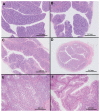Association of increased rate of condemnation of broiler carcasses due to hepatic abnormalities with immunosuppressive diseases in the broiler chicken industry in Saskatchewan
- PMID: 26424905
- PMCID: PMC4581669
Association of increased rate of condemnation of broiler carcasses due to hepatic abnormalities with immunosuppressive diseases in the broiler chicken industry in Saskatchewan
Abstract
The objective of this study was to identify the causative agents of hepatitis observed in broiler chickens at processing. Livers of chickens from 16 broiler farms in Saskatchewan with gross lesions of hepatitis were collected at processing. In addition to routine bacterial isolation and histopathological examination, serologic studies for infectious bursal disease virus (IBDV) and Chicken anaemia virus (CAV), calculation of the ratio of the weight of the bursa of Fabricius (BF) to body weight (BBW), and histopathological examination of the BF were done. Of the 264 livers with gross lesions, 83% had multifocal to coalescing necrotizing hepatitis, 16% had perihepatitis, and 1% had hemorrhages. No definitive causative microorganisms were isolated from the hepatic lesions; however, no significant bacterial isolations were made. Bursal atrophy, low BBW ratio, and high titer of antibody against IBDV each correlated with the rate of total condemnations (P = 0.0188, P = 0.0001, and P = 0.0073, respectively). Nucleotide sequencing of IBDV isolated from the BF identified the variant strains Delaware-E and 586. Condemnation because of hepatic lesions was correlated with titer of antibody against IBDV and BBW (P = 0.016 and P = 0.027). The results of this study demonstrate that hepatic lesions in Saskatchewan chickens are not currently caused by a primary bacterial pathogen but are associated with indicators of immunosuppression that is likely due to variant IBDV.
L’objectif de la présente étude était d’identifier les agents causals de l’hépatite observée chez des poulets à griller au moment de la transformation. Les foies de poulets provenant de 16 fermes de poulets à griller en Saskatchewan avec des lésions macroscopiques d’hépatite furent prélevés. En plus de l’isolement bactérien de routine et de l’examen histopathologique, on effectua des analyses sérologiques pour le virus de la bursite infectieuse aviaire (VBIA) et le virus de l’anémie du poulet (VAP), le calcul du ratio du poids de la bourse de Fabricius (BF) sur le poids corporel (BPC), et l’examen histopathologique de la BF. Sur les 264 foies ayant des lésions macroscopiques, 83 % avaient des lésions multifocales à coalescentes d’hépatite nécrosante, 16 % de la péri-hépatite et 1 % des hémorragies. Aucun agent causal définitif ne fut isolé des lésions hépatiques; toutefois, aucun agent bactérien significatif ne fut isolé. Une atrophie de la bourse, un faible ratio BPC, et un titre élevé d’anticorps dirigé contre VBIA corrélaient tous avec le taux de condamnation totale (P = 0,0188, P = 0,0001, et P = 0,0073, respectivement). Le séquençage nucléotidique des VBIA isolés des BF identifia les souches variantes Delaware-E et 586. La condamnation due aux lésions hépatiques était corrélée avec le titre d’anticorps contre VBIA et le BPC (P = 0,016 et P = 0,027, respectivement). Les résultats de la présente étude démontrent que les lésions hépatiques chez les poulets de la Saskatchewan ne sont pas actuellement causées par un agent bactérien pathogène primaire mais sont associées à des indicateurs d’immunosuppression qui est probablement causée par un variant de VBIA.(Traduit par Docteur Serge Messier).
Figures


Similar articles
-
A 5-year study of the incidence and economic impact of variant infectious bursal disease viruses on broiler production in Saskatchewan, Canada.Can J Vet Res. 2016 Oct;80(4):255-261. Can J Vet Res. 2016. PMID: 27733779 Free PMC article.
-
Effects of chicken anemia virus and infectious bursal disease virus in commercial chickens.Avian Dis. 2009 Mar;53(1):94-102. doi: 10.1637/8408-071408-Reg.1. Avian Dis. 2009. PMID: 19432010
-
Persistent infection with chicken anaemia virus and some effects of highly virulent infectious bursal disease virus infection on its persistency.Res Vet Sci. 1999 Dec;67(3):233-8. doi: 10.1053/rvsc.1999.0313. Res Vet Sci. 1999. PMID: 10607503
-
Poultry industry strategies for control of immunosuppressive diseases.Poult Sci. 1998 Aug;77(8):1193-6. doi: 10.1093/ps/77.8.1193. Poult Sci. 1998. PMID: 9706089 Review.
-
Viral diseases of the immune system and strategies to control infectious bursal disease by vaccination.Acta Vet Hung. 1997;45(3):239-49. Acta Vet Hung. 1997. PMID: 9276986 Review.
Cited by
-
Enhancing the value of meat inspection records for broiler health and welfare surveillance: longitudinal detection of relational patterns.BMC Vet Res. 2021 Aug 18;17(1):278. doi: 10.1186/s12917-021-02970-2. BMC Vet Res. 2021. PMID: 34407823 Free PMC article.
-
Residues 318 and 323 in capsid protein are involved in immune circumvention of the atypical epizootic infection of infectious bursal disease virus.Front Microbiol. 2022 Jul 29;13:909252. doi: 10.3389/fmicb.2022.909252. eCollection 2022. Front Microbiol. 2022. PMID: 35966653 Free PMC article.
-
The Incidence of Liver Damage Found during Postmortem Examination at the Slaughterhouse.Animals (Basel). 2023 Feb 25;13(5):839. doi: 10.3390/ani13050839. Animals (Basel). 2023. PMID: 36899698 Free PMC article.
References
-
- Canadian Food Inspection Agency. Poultry inspection programs. Meat Hygiene Manual of Procedures. [Last accessed June 18, 2015]. Available from: http://www.inspection.gc.ca/english/fssa/meavia/man/ch19/table19e.shtml.
-
- National Agricultural Statistics Service, United States Department of Agriculture. Poultry Slaughter. 2010 Summary. Feb, 2011. [Last accessed June 18, 2015]. Available from: http://usda.mannlib.cornell.edu/usda/nass/PoulSlauSu//2010s/2011/PoulSla....
-
- Agriculture and Agri-Food Canada. Poultry Condemnation Report by Species for Federally Inspected Plants (report 050P) [Last accessed June 18, 2015]. Available from: http://www3.agr.gc.ca/apps/aimis-simia/rp/index-eng.cfm?menupos=1.01.04&....
-
- Gomis SM, Watts T, Riddell C, Potter AA, Allan BJ. Experimental reproduction of Escherichia coli cellulitis and septicemia in broiler chickens. Avian Dis. 1997;1:234–240. - PubMed
-
- Lovland A, Kaldhusdal M. Severely impaired production performance in broiler flocks with high incidence of Clostridium perfringens-associated hepatitis. Avian Pathol. 2001;30:73–81. - PubMed
Publication types
MeSH terms
Substances
LinkOut - more resources
Full Text Sources
Miscellaneous
